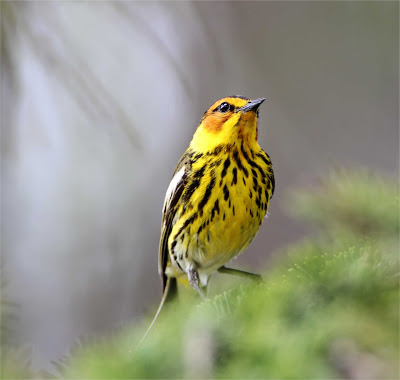I employed a guide in the Upper Peninsula, Skye Haas. He doesn't have a web site yet, but his email is here. I would highly recommend him to anyone heading that way.
The rarest bird in North America is the Kirtland's Warbler. It is only found in the jack pine forests of northern Michigan, so anyone wanting to see all the birds has to make this trip to Grayling Michigan. The Michigan Audubon runs trips to see it. There are currently about 1000 pairs of birds left, however, in 1970 there were only 200 pairs, so the intensive recovery effort to save this bird is paying off.
Fortunately for birders, it breeds in areas where the pines are young and short. The males sit on top of the small trees to sing and are about 6-8 feet off the ground. This was of course a lifer, as it was my first trip there.
 |
| Kirtland's Warbler - male |
Another lifer was the Connecticut Warbler. This bird doesn't migrate through Texas, so I had never seen it. The male has a gray hood, olive back and yellow breast. The complete white eye ring is an important field mark.
 |
| Connecticut Warbler - male |
 |
| Connecticut Warbler - male |
A similar, closely related bird is the Mourning Warbler. It also has the gray hood, olive back, and yellow belly. However, it has a black patch on the breast, and importantly, it lacks the eye ring. This bird is seen occasionally here in Houston, but I saw only one in the 7 years since doing photography and never got a picture.
 |
| Mourning Warbler - male |
 |
| Black-throated Blue Warbler - male |
The last of the new warbler photos was the Cape May Warbler. The male is distinctive with bright yellow underparts with black streaking and rusty cheek patches. I had seen it before, but not once in the last 7 years.
 |
| Cape May Warbler - male |
 |
| Cape May Warbler - male |
Happy birding and photography,
David McDonald dkmmdpa@gmail.com
photos copyright 2013 David McDonald
To have these trip reports sent to your email, please email me at the above address and ask to subscribe.
No comments:
Post a Comment